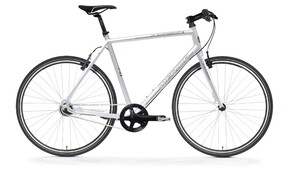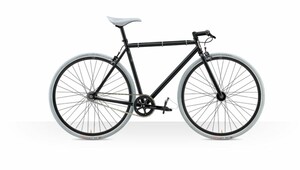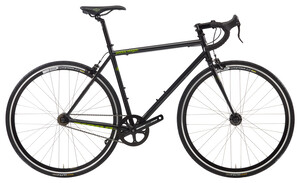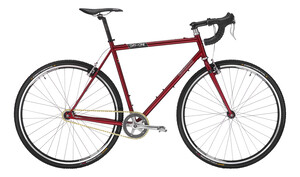The singlespeed bicycle is the most popular in the world, mostly because it's cheaper to have one gear. Yet in the last decade, the singlespeed has enjoyed a renaissance in the cities of Western countries. Cyclists who can readily afford machines with multiple gears are riding minimalist street bikes instead. Why?
The singlespeed bicycle is the most popular in the world, mostly because it's cheaper to have one gear. Yet in the last decade, the singlespeed has enjoyed a renaissance in the cities of Western countries. Cyclists who can readily afford machines with multiple gears are riding minimalist street bikes instead. Why?
Partly it's fashion. Fixed-wheel bikes – singlespeeds on which it is impossible to freewheel – have long been popular among big-city cycle couriers. Other urban cyclists adopted the same bikes, or at least bikes that looked like them.
The big disadvantage of a singlespeed bicycle is that you can't change down to an easier gear if you meet a hill or headwind, so you need flatter terrain and/or a decent level of fitness. The advantages only become evident when you're using your bike day in, day out, in all weathers. There's much less to go wrong on a singlespeed, and it's far cheaper to fix when anything does. It's lighter too.
The fixed-wheel bicycle is a sub-class of singlespeed that lacks a freewheel: when the rear wheel rotates so do the cranks, so you cannot stop pedalling while the bike is in motion. As long as there's a lock-ring to stop the fixed-sprocket unscrewing, you can slow the bike down by resisting the pedals. Legally this counts as a rear brake, so you are allowed to make do with just one hand-brake for the front wheel.
You sometimes see fixed-wheel bikes without any brakes. That's illegal in the UK, and in traffic it's dangerous. Even with one or two brakes, it takes a while to get used to the absorbing/unnerving sensation of riding 'fixed'. Do some test rides before you ride to work in traffic. You will instinctively start to freewheel as you approach junctions or corners, and the fixed-wheel bike will not permit this – the pedals will jerk your legs around.
Some off-the-peg singlespeeds have a rear wheel that will accept a fixed sprocket on one side and freewheel on the other, so you can choose between riding fixed or free – or between two different sprocket sizes. To change gear, you take the wheel out, turn it round, and refit it. Note that if you ever ride the bike in freewheel mode, it must have a front and rear brake.
The right size gear for a singlespeed will depend on your local terrain and pedalling preferences. As a rule of thumb, a chainring with about two-and-a-half times as many teeth as the sprocket will give you a reasonable single gear for the road. Other requirements are essentially the same as a comparable road bike or sports hybrid, although since you spend more time standing up on a singlespeed, it helps to have clipless pedals to keep your feet from slipping off them.
Here's just a snapshot of what's available.

Merida S'Presso Singlespeed
While some singlespeeds are ruthlessly pared down, with as few frame fitments as possible so as not to detract from the bike's minimalism, Merida's urban singlespeed is a hybrid that just happens to have one gear. As such, it's a far more practical commuter. The aluminium frame and fork will accept full mudguards, a pannier rack, a frame-mounted kickstand, and even disc brakes. Tyres are 35mm, which will cope better with badly surfaced streets than race bike tyres, and the V-brakes offer plenty of stopping power. The single 48/16 gear suits flat cities only; others will want an 18-tooth freewheel instead.
£350.00
www.merida-bikes.com
Specialized Globe Roll 1
This is the entry-level option in Specialized's range of three flat-bar singlespeeds, each of which puts a premium on aesthetics. The steel frame has band-on guides for the rear brake cable, so that if you decide to run a fixed gear on the 'flip-flop' (two-sided) rear hub, you can have a neater-looking, cable-free top tube. The stem and handlebar are integrated for a tidier look too. If you want mudguards, you'll be limited to Crud Roadracers or SKS Race Blades rather than frame-fitting guards. Bolt-on wheels are unlikely to be stolen if you lock the bike in town, however, and the sporty 23mm tyres come with puncture protection.
£400.00
www.specialized.com
Kona Paddy Wagon
This is a modern incarnation of the fixed-wheel winter training bike that road racers used to use in the off-season – to keep their best bike pristine and to perfect their pedalling action. It suits commuting too, and it's something of a rarity among today's fixies in that it's designed for mudguards, courtesy of frame eyelets and 57mm deep-drop brakes. Tyres are fatter too (28mm), which will help the resilient steel frame to take the edge off the buzz of road vibration. The rear wheel is a flip-flop one, so you can choose between fixed and freewheel gearing. Deservedly popular.
£650.00
www.konaworld.com
Genesis Day 01 Cross
This is a modern incarnation of the fixed-wheel winter training bike that road racers used to use in the off-season – to keep their best bike pristine and to perfect their pedalling action. It suits commuting too, and it's something of a rarity among today's fixies in that it's designed for mudguards, courtesy of frame eyelets and 57mm deep-drop brakes. Tyres are fatter too (28mm), which will help the resilient steel frame to take the edge off the buzz of road vibration. The rear wheel is a flip-flop one, so you can choose between fixed and freewheel gearing. Deservedly popular.

Comments: